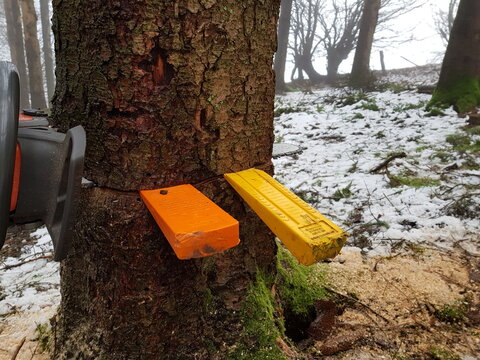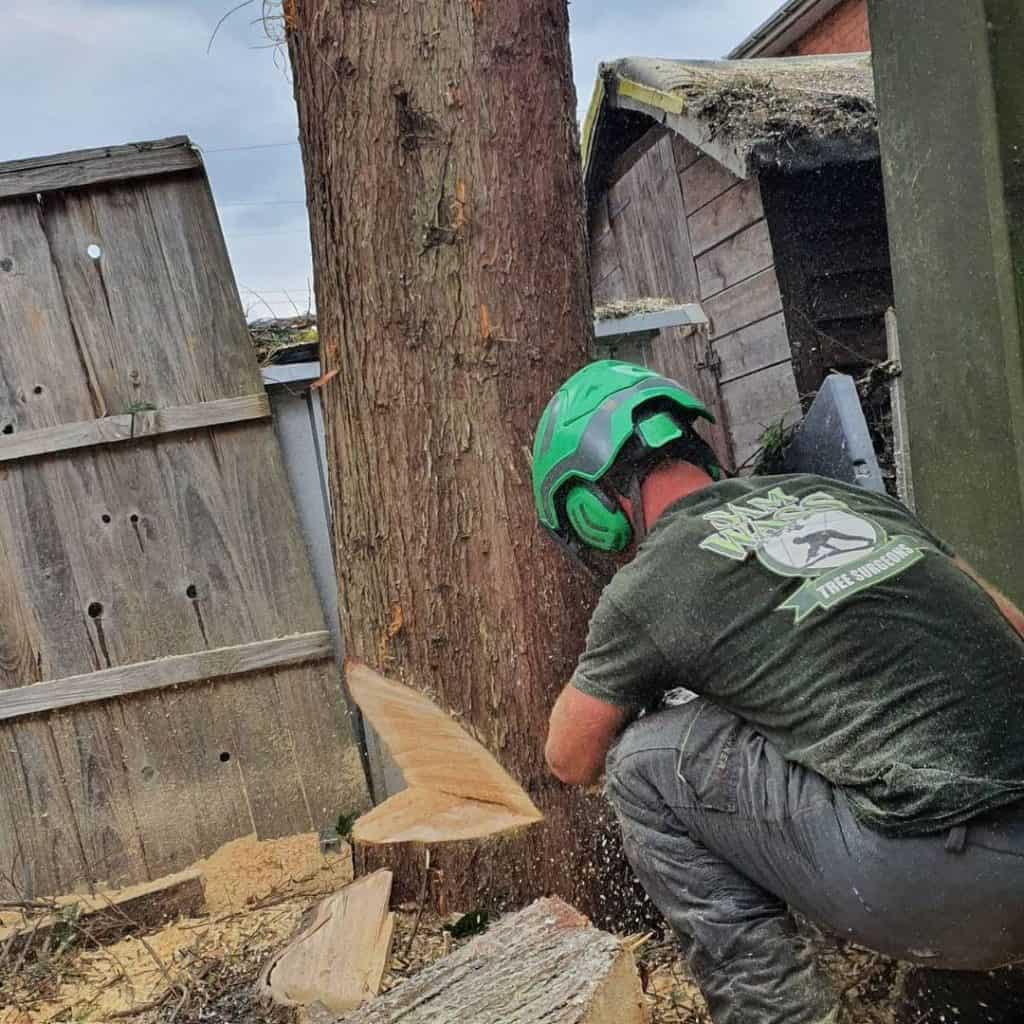Trees are an essential part of our environment, providing us with shade, oxygen, and aesthetic beauty. However, there are times when a tree needs to be removed for safety reasons, or to make way for construction or landscaping projects. While cutting down a tree may seem like a straightforward task, it can be extremely dangerous if not done correctly. In this guide, we will walk you through the process of safely cutting down a tree step by step.

Introduction
Before we delve into the specifics of tree cutting, it’s crucial to understand why it’s necessary and the potential risks involved. Trees may need to be removed if they are dead, diseased, pose a threat to structures or people, or simply if they’re in the way of a landscaping project. However, the process of cutting down a tree is not without hazards. Falling branches, the weight of the tree itself, and even the chainsaw you’re using can pose significant risks.
Preparations
Assessing the Tree
Before you even think about cutting a tree, it’s essential to assess its health and species. Different tree species require different cutting techniques, and a diseased or dying tree may behave unpredictably during the cutting process.
Obtaining Necessary Permits
In many areas, you may need a permit to cut down a tree, especially if it’s a large or protected tree. Check with your local authorities to ensure you have all the required permits before proceeding.
Gathering Tools and Safety Equipment
Safety should be your top priority when cutting down a tree. Here’s a list of essential tools and safety equipment:
- Chainsaw
- Safety goggles
- Helmet
- Gloves
- Hearing protection
- Work boots with good traction
- First aid kit

Planning the Cut
Choosing the Right Time
Select a time to cut the tree when weather conditions are favorable. Avoid cutting during strong winds, rain, or when the ground is slippery. A calm, dry day is ideal.
Identifying the Direction of Fall
Determine the direction in which you want the tree to fall. It should ideally fall in an open area away from structures, power lines, and other obstacles.
Creating an Escape Route
Plan a clear escape route that’s opposite to the direction of the falling tree. This route should be free from obstacles and should allow you to move quickly and safely.
Measuring and Marking the Cut
Measure and mark the point where you want to make the notch cut. The notch cut is a V-shaped cut that helps guide the tree’s fall.
Consideration for Branches and Obstacles
Take into account any branches or obstacles that may interfere with the tree’s fall. You may need to remove or trim these before making your cuts.
Making the Cut
The Undercut
The first cut you’ll make is the undercut, also known as the notch cut. It’s a horizontal cut made on the side of the tree facing the direction you want it to fall. The notch should be about one-third of the way through the tree trunk. Ensure the bottom of the notch is slightly above the point where you marked for the final cut.
The Back Cut
The back cut is made on the opposite side of the notch cut. It should be slightly above the bottom of the notch cut and slightly behind it. This cut should be horizontal and parallel to the ground.
The Felling Cut
The felling cut is the final cut that will cause the tree to fall. It should be made slightly above the horizontal back cut and should leave a small “hinge” of uncut wood. This hinge will guide the tree’s fall.
Avoiding Kickbacks
Be cautious of the chainsaw’s kickback. Kickback occurs when the chainsaw’s nose or tip strikes an object. Keep the chainsaw’s tip away from the tree as you cut, and be prepared for any sudden movements.
Using Wedges to Control the Fall

If the tree doesn’t fall as planned, you can use wedges to control its direction. Insert the wedges into the back cut to encourage the tree to fall in the desired direction.
Tips for Handling the Chainsaw Safely
- Maintain a firm grip on the chainsaw with both hands.
- Keep your body to the side of the saw, not in line with the cutting chain.
- Never work alone; have a spotter who can call for help in case of an emergency.
After the Tree Falls
Clearing the Work Area
Once the tree has fallen, clear the work area of branches and debris to prevent tripping hazards.
Dealing with Branches and Debris
Use a chainsaw to cut the branches into manageable pieces for disposal or use as firewood. Dispose of any debris responsibly, following local regulations.
Stump Removal Options
You can choose to leave the stump or remove it, depending on your landscaping plans. Stump removal methods include grinding, chemical treatments, or simply allowing it to decompose naturally.
Safety Tips
Staying Alert and Focused
Throughout the tree-cutting process, remain focused and attentive. Avoid distractions and stay aware of your surroundings.
Maintaining the Chainsaw
Regularly maintain your chainsaw by keeping it sharp and in good working condition. A well-maintained chainsaw is safer and more efficient.
Safety Precautions for Working Alone
If you must work alone, make sure someone knows your location and the expected duration of your work. Carry a communication device in case of emergencies.
First Aid and Emergency Planning
Always have a first aid kit on hand, and know how to use it. Additionally, have a plan for emergencies, including the contact information for local emergency services.
Hiring Professionals
When to Hire an Arborist or Tree Removal Service
For large or complex tree removals, or if you are unsure about your abilities, it’s best to hire a professional arborist or tree removal service. They have the experience and equipment needed to safely remove trees.
How to Choose a Reputable Tree Removal Company
When hiring professionals, research and choose a reputable tree removal company. Check for certifications, insurance, and references.
What to Expect from Professionals
Professionals will assess the tree, provide a detailed plan, and carry out the removal safely and efficiently. They will also clean up the debris and may offer stump removal services.
Conclusion
In conclusion, cutting down a tree safely is a task that requires careful planning, the right equipment, and a strong focus on safety. It’s essential to assess the tree’s health, obtain any necessary permits, and follow a step-by-step process that minimizes risks. Remember that safety should always be your top priority, and when in doubt, consider hiring a professional tree removal service.

Additional Resources
For more information on tree cutting and safety guidelines, you can refer to the following resources:

